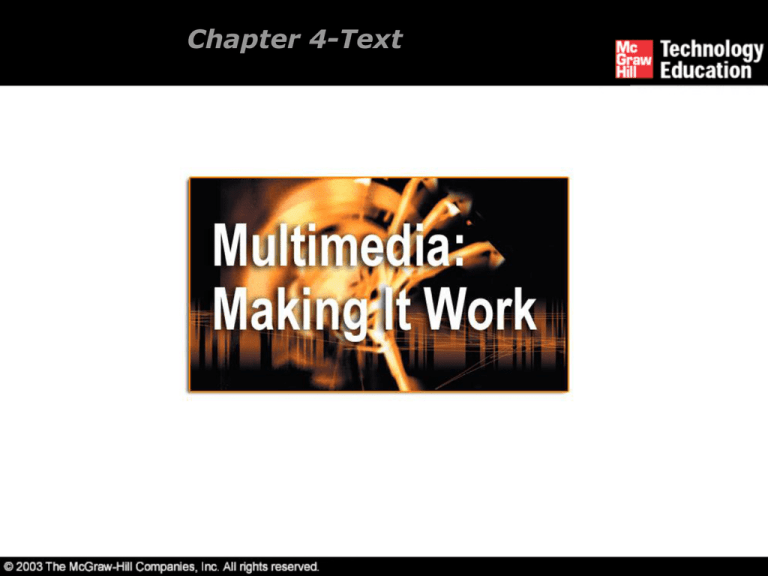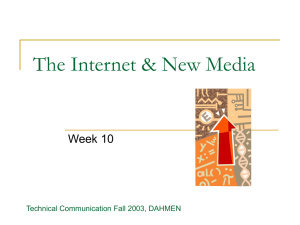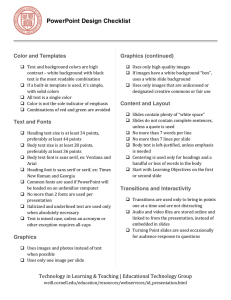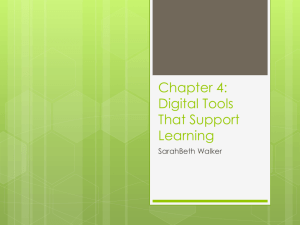Chapter 4-Text
advertisement

Chapter 4-Text Overview Importance of text in a multimedia presentation. Understanding fonts and typefaces. Using text elements in a multimedia presentation. Computers and text. Font editing and design tools. Multimedia and hypertext. Importance of Text in a Multimedia Presentation Words and symbols in any form, spoken or written, are the most common means of communication. Text is a vital element of multimedia menus, navigation systems, and content. Importance of Text in a Multimedia Presentation Factors affecting legibility of text: Size. Background and foreground color. Style. Leading: Computer fonts automatically add space below the descender (and sometimes above) to provide appropriate line spacing or leading named for the thin strips of lead inserted b/w the lines by traditional typesetters . Understanding Fonts and Typefaces A ‘typeface’ is a family of graphic characters that usually includes many type sizes and styles. A ‘font’ is a collection of characters of a single size and style belonging to a particular typeface family. Understanding Fonts and Typefaces The study of fonts and typefaces includes the following: Font styles. Font sizes. Cases. Serif versus Sans Serif. Font Styles Font styles include: Boldface Italic Underlining Outlining Font Sizes Font size is measured in points. Character metrics are the general measurements applied to individual characters. Kerning is the spacing between character pairs. Leading is the space between lines. Cases A capitalized letter is referred to as 'uppercase', while a small letter is referred to as 'lowercase.' Placing an uppercase letter in the middle of a word is referred to as intercap. Serif Versus Sans Serif Serif is the little decoration at the end of a letter stroke. Serif fonts are used for body text. Sans serif fonts do not have a serif at the end of a letter stroke. These fonts are used for headlines and bold statements. Using Text Elements in a Multimedia Presentation The text elements used in multimedia are: Menus for navigation. Interactive buttons. Fields for reading. HTML documents. Symbols and icons. Menus for Navigation A user navigates through content using a menu. A simple menu consists of a text list of topics. Interactive Buttons A button is a clickable object that executes a command when activated. Users can create their own buttons from bitmaps and graphics. The design and labeling of the buttons should be treated as an industrial art project. Fields for Reading Reading a hard copy is easier and faster than reading from the computer screen. A document can be printed in one of two orientations - portrait or landscape. Fields for Reading The taller-than-wide orientation used for printing documents is called portrait. The wider-than-tall orientation that is normal to monitors is called landscape. HTML Documents HTML stands for Hypertext Markup Language. It is the standard document format used for Web pages. HTML documents are marked using tags. HTML Documents An advanced form of HTML is DHTML. DHTML stands for Dynamic Hypertext Markup Language. DHTML uses Cascading Style Sheets (CSS). HTML Documents Some of the commonly used tags are: The <B> tag for making text bold faced. The <OL> tag for creating an ordered list. The <IMG> tag for inserting images. Symbols and Icons Symbols are concentrated text in the form of stand-alone graphic constructs. They are used to convey meaningful messages. Symbols used to convey human emotions are called emoticons. Icons are symbolic representations of objects and processes. Using Text Elements in a Multimedia Presentation Anti-aliased text must be used when a gentle and blended look for titles and headlines is needed. Ideas and concepts can be highlighted by making the text bold or by emphasizing text. A pleasant look can be created by experimenting with different font faces, sizes, leadings, and kerning. Computers and Text The font wars. Character sets. The Font Wars PostScript TrueType PostScript PostScript is a method of describing an image in terms of mathematical constructs. PostScript characters are scalable and can be drawn much faster. The two types of PostScript fonts are Type 3 and Type 1. TrueType Apple and Microsoft developed the TrueType methodology. TrueType is a system of scalable outline fonts, and can draw characters at low resolution. Character Sets The American Standard Code for Information Interchange (ASCII) is a 7-bit coding system. The extended character set is commonly filled with ANSI standard characters. The ISO-Latin-1 character set is used while programming the text of HTML pages. Character Sets Unicode is a 16-bit architecture for multilingual text and character encoding. The shared symbols of each character set are unified into collections of symbols called scripts. Character Sets Mapping across platforms: Fonts and characters are not cross-platform compatible. They must be mapped to the other machine using font substitution. Font Editing and Design Tools Macromedia Fontographer. Creating attractive texts. Macromedia Fontographer Fontographer is a specialized graphics editor. It is compatible with both Macintosh and Windows platform. It can be used to develop PostScript, TrueType, and bitmapped fonts. It can also modify existing typefaces and incorporate PostScript artwork. Creating Attractive Texts Applications that are used to enhance texts and images include: Adobe Photoshop TypeStyler COOL 3D HotTEXT TypeCaster Multimedia and Hypertext Multimedia. Hypertext system. Using hypertext systems. Searching for words. Hypermedia structures. Hypertext tools. Multimedia Multimedia is defined as the combination of text, graphics, and audio elements into a single presentation. When the user assumes control over the presentation, it is called interactive multimedia. Interactive multimedia becomes hypermedia when a structure of linked elements is provided to the user for navigation and interaction. Hypertext System Hypertext is defined as the organized cross-linking of words, images, and other Web elements. A system in which words are keyed or indexed to other words is referred to as a hypertext system. A hypertext system enables the user to navigate through text in a non-linear way. Using Hypertext Systems Information management and hypertext programs present electronic text, images, and other elements in a database fashion. Software robots visit Web pages and index entire Web sites. Using Hypertext Systems Hypertext databases make use of proprietary indexing systems. Server-based hypertext and database engines are widely available. Searching for Words Typical methods for word searching in hypermedia systems are: Categorical search Word relationship Adjacency Alternates Association Searching for Words Typical methods for word searching in hypermedia systems are (continued): Negation Truncation Intermediate words Frequency Hypermedia Structures Links. Nodes. Anchors. Navigating hypermedia structures. Links Links are connections between conceptual elements. Links are the navigation pathways and menus. Nodes Nodes are accessible topics, documents, messages, and content elements. Nodes and links form the backbone of a knowledge access system. Anchors Anchor is defined as the reference from one document to another document, image, sound, or file on the Web. The source node linked to the anchor is referred to as a link anchor. The destination node linked to the anchor is referred to as a link end. Navigating Hypermedia Structures The simplest way to navigate hypermedia structures is via buttons. Location markers must be provided to make navigation user-friendly. Hypertext Tools Two functions common to most hypermedia text management systems are building (authoring) and reading. Hypertext Tools The functions of ‘builder’ are: Creating links. Identifying nodes. Generating an index of words. Hypertext Tools Hypertext systems are used for: Electronic publishing and reference works. Technical documentation. Educational courseware. Interactive kiosks. Electronic catalogs. Summary Text is one of the most important elements of multimedia. The standard document format used for Web pages is called HTML. Multimedia is the combination of text, graphics, and audio elements into a single presentation. A hypertext system enables the user to navigate through text in a non-linear way.




